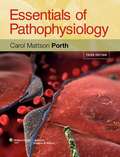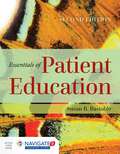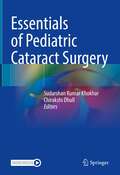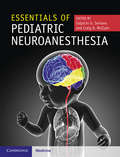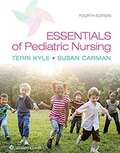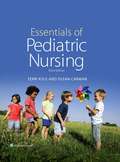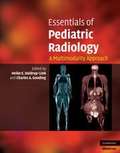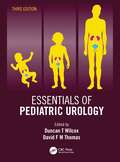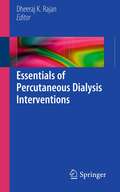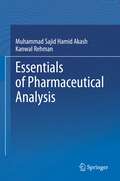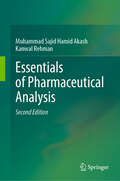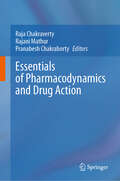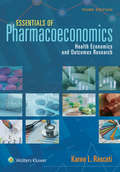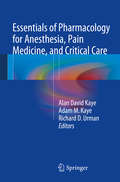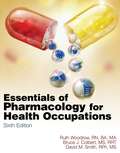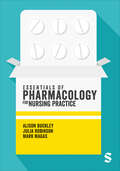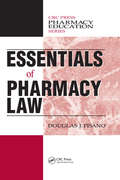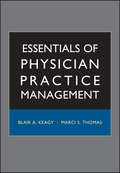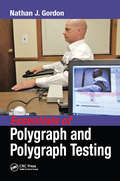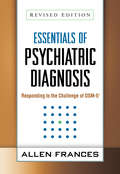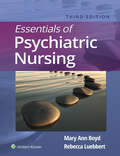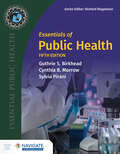- Table View
- List View
Essentials of Pathophysiology: Concepts of Altered Health States (3rd Edition)
by Glenn Matfin Carol M. PorthThe text, which is based on the eighth edition of Pathophysiology: Concepts of Altered Health, has been prepared specifically for those students who do not need the extensive breadth or detail of content provided in the larger book. To accomplish this task, content deemed to be less essential has been omitted, while essential content has been reorganized, revised, and condensed.
Essentials of Patient Education
by Susan B. BastableEach new print copy includes Navigate 2 Advantage Access that unlocks a comprehensive and interactive eBook, student practice activities and assessments, a full suite of instructor resources, and learning analytics reporting tools. Essentials of Patient Education, Second Edition prepares nurses for their increasing role in patient teaching, health education and health promotion. Highly revised, the Second Edition focuses on the basic principles of teaching and learning by emphasizing the role of the professional nurse in educating patients and families effectively and efficiently in various healthcare settings. The Second Edition explores new topics of motor learning and gender differences in the brain as well as, the ethics of patient education and the legal role of the nurse as mandated by state practice. The text features completely revised chapter content and updated references that provide evidence from research and theoretical foundations which substantiate content throughout the text. Key Features: Coverage of health literacy Chapters dedicated to gender, socioeconomics, culture and persons with disabilities Discussion of compliance and motivation issues Includes the determinants of learning which captures critical information on the learner Case studies offer the opportunity to apply the teaching and learning principles featured in the chapter Instructor Resources: Lecture outlines in PowerPoint format Learning Activities Assessments
Essentials of Pediatric Anesthesiology
by Charles James Fox F.A.A.P. Alan David Kaye M. P. H. Ph.D. Charles James Fox James H. Diaz Dr P. H. D.A.B.A.Numerous studies indicate that outcomes for pediatric patients are improved when the anesthesia caregiver has advanced training and knowledge of pediatric anesthesiology. Essentials of Pediatric Anesthesiology is a unique new handbook, providing a clinically relevant and easy-to-read review of all key topics in this important field. Written and edited by leading pediatric anesthesia physicians, each chapter takes a consistent approach, guaranteeing this book is user-friendly and authoritative throughout. Topics include physiology, anatomy, equipment, a comprehensive overview of relevant disease states, and special topics such as regional anesthesia, complications, and anesthesia for remote locations. Numerous diagrams, tables and figures help to organize the information for easy reference. Whether you choose to dip into a particular chapter or read the book cover to cover, Essentials of Pediatric Anesthesiology is a valuable review book for all residents, fellows and clinical practitioners needing to improve or refresh their understanding of pediatric anesthesia management.
Essentials of Pediatric Cataract Surgery
by Sudarshan Kumar Khokhar Chirakshi DhullThe book highlights various pediatric cataract surgeries. It covers variants of pediatric cataract along with other rare morphologies. It covers selected challenging clinical situations along with surgical management steps. Additionally, it includes the management of surgical complications. The book provides relevant concise text supported by clinical pictures and includes 50 short videos. This book is a collection of clinical images and videos over 2 decades. Chapters cover recent advances in the field of pediatric cataract, such as ultrasound biomicroscopy, intraoperative rhexis assistant, operative room aberrometry. The accompanying video describes the surgical procedures with a voiceover lucidly explaining every step. It discusses unique cases of buphthalmous with cataract, anterior segment dysgenesis, persistent fetal vasculature and pre-existing persistent capsular defect with their latest management techniques.This book is relevant for practicing ophthalmologists and students alike.
Essentials of Pediatric Neuroanesthesia
by Sulpicio G. Soriano Craig D. McClainDue to the differences in the neurophysiology and cranial development of infants and children, the anesthetist's approach to the pediatric neurosurgical patient cannot simply be modelled on that for adults. Infants and children undergoing anesthesia for neurosurgical procedures therefore present unique challenges for the anesthetist. Essentials of Pediatric Neuroanesthesia is a practical guide to best practice in managing the perioperative care of pediatric neurosurgical patients, providing comprehensive information on the techniques to administer anesthesia and sedation to this vulnerable patient group. The chapters, written by leading experts, highlight clinical pearls as well as key recommended references, providing rapid access to vital information in the care of the pediatric neurosurgical patient. It is the first book of its kind to be dedicated solely to neuroanesthesia for pediatric patients, making it an essential read for both experienced and trainee pediatric anesthetists and neuroanesthetists.
Essentials of Pediatric Nursing
by Theresa Kyle Susan CarmanEssentials of Pediatric Nursing, 4th Edition, helps students develop the clinical reasoning capability to confidently meet the unique challenges of caring for children and their families in a wide variety of healthcare settings. Utilizing the nursing process, a concise, concept-based approach makes relevant information accessible and builds students’ understanding progressively from concept to application. Rather than repeating medical-surgical content previously mastered, the text builds upon students’ prior knowledge, establishing an understanding of broad concepts before cultivating students’ critical thinking and problem-solving skills. <p><p> Covering a wide scope of relevant topics with an emphasis on common issues and pediatric-specific content, Essentials of Pediatric Nursing focuses on conceptual learning to help you make the most of your class time and ensure that your students are equipped for a successful career in pediatric nursing care. This updated edition introduces new Unfolding Case Studies and Clinical Reasoning Alerts that encourage discussion and clinical decision-making, as well as new Practice and Learn Growth and Development Case Studies and Skill-based Pediatric Videos on thePoint that guide students through commonly encountered scenarios and applications to equip them for the rigors of pediatric practice.
Essentials of Pediatric Nursing, 3rd Edition
by Theresa Kyle Susan CarmanEssentials of Pediatric Nursing is intended for Pediatric Nursing courses with an integrated pediatric curriculum. It provides a unique concept-based approach and nursing process focus that helps students go from concept to application by building on previously mastered knowledge from other courses. The new edition of the text focuses on allowing students to apply concepts from the book to cases throughout the book. It also emphasizes developmental considerations and atraumatic care, illustrating the unique nature of a pediatric patient. Also new to this edition are highlighted sections, showing student,,s key areas in the text that students commonly struggle with and real life critical thinking exercises. This edition will have a comprehensive supplements program to support faculty and student needs, in addition to a pediatric nursing videos series available on thePoint. Features: Hallmark Features and Key Revisions/Update: New: Misconception Alert, Boxes focusing on items that "students often misunderstand", drawn from PrepU. Feature subtly branded to PrepU. Aim to help students focus. , New: Dose Calc Box, Dose Calculation Boxes: Keeping the focus on differences between adult and child patients at the front of student,,s minds. , New: End of Chapter Case, End of chapter case study to apply course content. Phase I of case is in the book and entire unfolding case study is on thePoint. Linking print/digital. , New: Bringing it all Together, Segment drawing content application from from multiple chapters, to develop dynamic/critical thinking. Including prioritization, development, etc. To be located at end of chapters for all of unit 4. , Update: Threaded/Unfolding Case, Making note of the 'unfolding case,,, at each feature occurrence, throughout each chapter and aligning photo in chapter opener to small photo assigned with threaded case to make feature more visible to students. , Update: Worksheet, Including a question focusing on dosage calculation in the worksheet, Update: Developmental Considerations, Adding more developmental considerations throughout the book to help students understand the importance/difference between children/adults, Update: Key Terms, Putting more advanced terms in this section of the book, Update: Teaching Guidelines, Making these briefer and adjusting formatting for brevity, Update: Consider This, Guidelines on thePoint for answers/guidance on how to reach answers with page numbers, Visual preface, Preface to have visual walk through of key features,
Essentials of Pediatric Radiology
by Heike E. Daldrup-Link Charles A. GoodingEssentials of Pediatric Radiology: A Multimodality Approach provides a concise overview of both basic and complex topics encountered by pediatric radiologists in their daily practice. Written by leading pediatric radiologists from renowned children's hospitals, it focuses particularly on multimodality imaging, covering the full gamut of radiologic diagnostic techniques, including conventional radiography and ultrasound, Doppler ultrasound, up-to-date CT and MRI techniques, and PET-CT. Each chapter is generously illustrated with high quality images, as well as graphs, tables, decision flowcharts and featured cases. Chapters are arranged according to pathologies, rather than organ systems, providing the reader with clinically-oriented information when employing 'whole body' techniques or analysing scans involving multiple anatomical sites. The book is complemented by online presentations of cases as 'unknowns', which enable readers to test their diagnostic proficiency. A key text for pediatric radiology fellows, radiology residents and general radiologists, this is also essential reading for all pediatricians.
Essentials of Pediatric Radiology
by Heike E. Daldrup-Link Charles A. GoodingUnlike most existing textbooks on the economic history of modern Europe, which offer a country-by-country approach, The Cambridge Economic History of Modern Europe rethinks Europe's economic history since 1700 as unified and pan-European, with the material organized by topic rather than by country. This second volume tracks Europe's economic history through three major phases since 1870. The first phase was an age of globalization and of European economic and political dominance that lasted until the First World War. The second, from 1914 to 1945, was one of war, deglobalization, and depression and the third was one of growing integration not only within Europe but also between Europe and the global economy. Leading authors offer comprehensive and accessible introductions to these patterns of globalization and deglobalization as well as to key themes in modern economic history such as economic growth, business cycles, sectoral developments, and population and living standards.
Essentials of Pediatric Urology
by Duncan T Wilcox David F M ThomasEssentials of Pediatric Urology provides surgical trainees with an up to date and comprehensive account of the urological disorders of childhood . In addition, this popular textbook makes a valuable practical contribution to clinical decision making by Adult Urologists and General Pediatric Surgeons who treat conditions of the genitourinary systems in children. This established resource fulfils a unique role as the only international textbook of Pediatric Urology written primarily for trainees and those practising adult Urology, Pediatric Surgery, and Pediatric Urology. The third edition continues to meet this need as well as providing a ready source of reference for non-specialists including Pediatricians and Nurses.
Essentials of Percutaneous Dialysis Interventions
by Dheeraj RajanAs the dialysis population grows, an expert medical resource on the percutaneous creation and maintenance of vascular access is much needed. This book fulfills exactly that need, engaging interventional radiologists, vascular surgeons, interventional nephrologists, and the medical support personnel serving these patients. Providing a clear understanding of best techniques and practices, the authors present an unbiased discussion of patient preparation, procedures, and new devices and equipment. Logically organized and concluding with a compelling collection of 15 noteworthy cases, the book is the culminating work of leading experts in their specialties. The first truly practical reference dedicated to this topic, Essentials of Percutaneous Dialysis Interventions extends across multiple medical specialties to address a global health problem. Easy to use, reader-friendly, and portable, experienced practitioners and trainees alike will find this book to be of daily value.
Essentials of Pharmaceutical Analysis
by Kanwal Rehman Muhammad Sajid AkashRecent advances in the pharmaceutical sciences and biotechnology have facilitated the production, design, formulation and use of various types of pharmaceuticals and biopharmaceuticals. This book provides detailed information on the background, basic principles, and components of techniques used for the analysis of pharmaceuticals and biopharmaceuticals. Focusing on those analytical techniques that are most frequently used for pharmaceuticals, it classifies them into three major sections and 19 chapters, each of which discusses a respective technique in detail. Chiefly intended for graduate students in the pharmaceutical sciences, the book will familiarize them with the components, working principles and practical applications of these indispensable analytical techniques.
Essentials of Pharmaceutical Analysis
by Kanwal Rehman Muhammad Sajid AkashThis 2nd edition of the comprehensive resource on pharmaceutical analysis and analytical techniques builds upon the success of its first edition by incorporating updated methodologies, expanded content, and fresh insights into modern practices. Designed for students, researchers, and industry professionals alike, the book bridges theoretical principles with practical applications, covering both classical methods and innovative approaches across spectrophotometry, chromatography, mass spectrometry, and thermal analysis. Detailed chapters elucidate method development, instrumentation, quality control, and regulatory compliance, while enriched case studies and examples from environmental science, biomedical research, and materials science illustrate real-world applications. New sections highlight the integration of miniaturized instruments, hyphenated techniques, and computational tools including machine learning and cloud-based analytics. Enhanced diagrams, tables, and summaries further facilitate the understanding of complex analytical concepts. This edition not only reinforces essential foundational knowledge but also equips readers with advanced practical skills to meet evolving challenges in pharmaceutical research and quality assurance. Whether you are seeking a solid academic grounding or aiming to adopt cutting-edge techniques, this book provides an indispensable guide to mastering contemporary pharmaceutical analysis and the future of analytical chemistry. With its rigorous and accessible approach, this book serves as an essential reference that inspires innovation in analytical sciences.
Essentials of Pharmacodynamics and Drug Action
by Raja Chakraverty Rajani Mathur Pranabesh ChakrabortyThe book provides a comprehensive exploration of the dynamic field of pharmacology and its fundamental principles. It delves into the intricate interactions between drugs and the human body, focusing on pharmacokinetics, which explains the dynamics of drug actions in the body, and pharmacodynamics, which uncovers the mechanisms through which drugs exert their effects. The book also emphasizes the crucial aspects of therapeutics and gene-based therapy, shedding light on modern approaches to disease treatment. Readers will gain insights into drugs that target the autonomic nervous system, influencing functions beyond voluntary control, and drugs that act on the central nervous system, impacting neurological processes. Additionally, the book examines medications affecting renal and cardiovascular functions, playing a significant role in maintaining homeostasis. Moreover, it explores the realm of drugs influencing gastrointestinal function, essential for digestive health.Furthermore, the book covers pharmacotherapy for microbial diseases, addressing the challenge of infectious agents and their treatment. It also investigates hormones and hormone antagonists, pivotal in regulating various physiological processes. Lastly, it provides a comprehensive understanding of drugs used for immunomodulation, which plays a crucial role in enhancing or suppressing the immune system.The book serves as a resource for students, researchers, and healthcare professionals seeking a deep understanding of drug interactions, therapeutic applications, and cutting-edge approaches in pharmacology.
Essentials of Pharmacoeconomics
by Karen RascatiDesigned as a true introduction to the subject, Essentials of Pharmacoeconomics: Health Economics and Outcomes Research, ThirdEdition includes information on fundamental topics, defines terminology, and provides examples for evaluating published research, making it perfect for any pharmacy student or practitioner new to the topic. This updated edition provides the critical foundations of knowledge for measuring costs and health-related quality-of-life (HRQoL) and evaluating the four types of studies (CMA, CEA, CUA, and CBA); it also explains Markov and Budget Impact Analysis modeling, and discusses the advantages and disadvantages of using retrospective databases and real-world data (RWD). Additionally, the text summarizes the use of pharmacoeconomic evaluations by decision makers outside of the United States and the extent to which pharmacoeconomic data are used to make decisions in the United States, includes barriers to its use, and discusses future issues. All of this information is designed to ensure preparedness to improve clinical and humanistic outcomes based on available resources.
Essentials of Pharmacology for Anesthesia, Pain Medicine, and Critical Care
by Richard D. Urman Alan David Kaye Adam M. KayeIn anesthesiology, pain medicine, and critical care, practitioners at all levels need help to stay current with the continually evolving drug knowledge-base and trainees need tools to prepare for in-training and board exams that increasingly test their knowledge of pharmacology. This practical book is aimed at both readerships. It features a unique and practical chapter on the United States Food and Drug Administration (FDA) "black box" warnings that describe what safety precautions should be taken with commonly used drugs. The editors and contributors are pharmacology experts representing a cross-section of clinical specialties and institutions in the United States and include pharmacologists, pharmacists, as well as physicians.
Essentials of Pharmacology for Health Occupations (6th Edition)
by David M. Smith Ruth Woodrow Bruce J. ColbertThis basic introductory text presents information about pharmacology and the safe administration of medications.
Essentials of Pharmacology for Nursing Practice
by Alison Buckley Julia Robinson Mark MagasHow do medicines work? How do they interact with the body? What do I need to know for my nursing studies and practice? This book introduces the principles and practice of pharmacology in clear and simple terms. It follows the journey that medicines take in the body, explaining the main pharmacokinetic stages from the site of drug administration, through to metabolism and excretion, and considers the principles of drug action. Using straightforward language and assuming no prior knowledge of related anatomy and physiology, it builds your understanding before ending in a chapter of case studies, illustrating how the pharmacological principles you’ve learned apply to everyday nursing scenarios. It is the ideal introduction for all pre-registration nursing students beginning their journey towards future prescribing roles.
Essentials of Pharmacology for Nursing Practice
by Alison Buckley Julia Robinson Mark MagasHow do medicines work? How do they interact with the body? What do I need to know for my nursing studies and practice? This book introduces the principles and practice of pharmacology in clear and simple terms. It follows the journey that medicines take in the body, explaining the main pharmacokinetic stages from the site of drug administration, through to metabolism and excretion, and considers the principles of drug action. Using straightforward language and assuming no prior knowledge of related anatomy and physiology, it builds your understanding before ending in a chapter of case studies, illustrating how the pharmacological principles you’ve learned apply to everyday nursing scenarios. It is the ideal introduction for all pre-registration nursing students beginning their journey towards future prescribing roles.
Essentials of Pharmacy Law (Pharmacy Education Ser.)
by Douglas J. PisanoThis book is a compilation and commentary of selected laws and regulations pertaining to the general practice of pharmacy in the United States. It is designed to be of assistance to practicing pharmacists, those seeking licensure by reciprocity, and other interested healthcare professionals.
Essentials of Physician Practice Management
by Marci S. Thomas Blair A. KeagyEssentials of Physician Practice Management offers a practical reference for administrators and medical directors and provides a comprehensive text for those preparing for a career in medical administration, practice management, and health plan administration. Essentials of Physician Practice Management is filled with valuable insights into every aspect of medical practice management including operations, financial management, strategic planning, regulation and risk management, human resources, and community relations.
Essentials of Polygraph and Polygraph Testing
by Nathan J. GordonThroughout history, there has been an intrinsic need for humans to detect deception in other humans. Developed in 1923, the polygraph machine was a tool designed to do just this. To date, there have been many improvements made to the basic polygraph instrument. This book outlines the instrumentation as well as the latest in questioning techniques and methods available to the professional interviewer to determine truth from deception. The book covers psychology and physiology, a history of polygraph with the advances of leading figures, question formulation, data analysis, legal implications and legal cases, and the author’s developed technique Integrated Zone Comparison Technique (IZCT).
Essentials of Psychiatric Diagnosis, Revised Edition: Responding to the Challenge of DSM-5®
by Allen FrancesGrounded in author Allen Frances's extensive clinical experience, this comprehensive yet concise guide helps the busy clinician find the right psychiatric diagnosis and avoid the many pitfalls that lead to errors. Covering every disorder routinely encountered in clinical practice, Frances provides the ICD-9-CM codes and (where feasible) ICD-10-CM codes required for billing, a useful screening question, a colorful descriptive prototype, lucid diagnostic tips, and a discussion of other disorders that must be ruled out. The book closes with an index of the most common presenting symptoms, listing possible diagnoses that must be considered for each. Frances was instrumental in the development of past editions of the DSM and provides helpful cautions on questionable aspects of DSM-5. The revised edition features ICD-10-CM codes where feasible throughout the chapters, plus a Crosswalk to ICD-10-CM codes in the Appendix. The Appendix, links to further coding resources, and periodic updates can also be accessed at the companion website.
Essentials of Psychiatric Nursing
by Mary Ann Boyd Rebecca LuebbertHelp beginning nursing students gain the basic knowledge, therapeutic communication capabilities, and patient interaction skills to confidently prepare for psychiatric nursing practice. Easy to use and backed by the latest clinical evidence, Essentials of Psychiatric Nursing, 3rd Edition, is rich with clinical examples and explanations that help clarify challenging concepts and equip students for success as entry-level nurses. Whether used in dedicated psychiatric nursing courses or for integrating psychiatric nursing principles into an existing course, this engaging text establishes the fundamental understanding students need to effectively care for individuals with emotional and mental health problems in any healthcare setting. New and Updated Features NEW! Content helps students recognize and address the effects of COVID-19 on mental health and embrace changes in the practice and delivery of mental health nursing, such as virtual therapy. UPDATED! Coverage of veteran care empowers students to confidently manage specific mental health issues affecting military veterans and their families. UPDATED! Community nursing care coverage helps students make a confident transition to practice outside of traditional hospital settings, increasing their career prospects.
Essentials of Public Health
by Cynthia B. Morrow Guthrie S. Birkhead Sylvia PiraniEssentials of Public Health, Fifth Edition is a thorough introduction to the field of public health, blending public health practice concepts, government public health, and careers in public health.Using the concept of Public Health 3.0 (a set of aspirational goal to move the public health system into the future), the first section delves into foundational public health principles, governmental structures, healthcare relationships, and pandemic preparedness, offering a thorough understanding of the field. The second section uniquely highlights various public health occupations and careers, equipping readers with an understanding of the diverse roles within the public health workforce. Covers the latest trends and concepts including the 10 Essential Public Health Services (EPHS), Health People 2030, health equity, and more.Offers a new chapter (6) entitled Pandemic and All-Hazards Public Health Preparedness which emphasizes the critical lessons learned from the COVID-19 pandemic and highlights the essential role of public health in safeguarding community health during emergencies.Uniquely explores public health careers, offering 6 job-specific chapters covering careers in Public Health Administration, Environmental & Occupational Health; Public Health Nursing; Epidemiology & Statistics and more. Features updated tables, figures, and weblinks throughout the text illustrate key concepts and provide useful resources. Includes revised and expanded "Outside-the-book" thinking exercises as well as discussion questions to engage students further. Introductory Public Health courses in Public Health, Nursing, and other health disciplines. © 2026 | 350 pages
